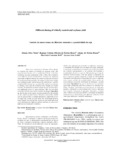Por favor, use este identificador para citar o enlazar este ítem:
http://www.alice.cnptia.embrapa.br/alice/handle/doc/951267Registro completo de metadatos
| Campo DC | Valor | Lengua/Idioma |
|---|---|---|
| dc.contributor.author | VIEIRA, S. S. | pt_BR |
| dc.contributor.author | BUENO, R. C. O. de F. | pt_BR |
| dc.contributor.author | BUENO, A. de F. | pt_BR |
| dc.contributor.author | BOFF, M. I. C. | pt_BR |
| dc.contributor.author | GOBBI, A. L. | pt_BR |
| dc.date.accessioned | 2013-02-26T11:11:11Z | pt_BR |
| dc.date.available | 2013-02-26T11:11:11Z | pt_BR |
| dc.date.created | 2013-02-26 | pt_BR |
| dc.date.issued | 2013 | pt_BR |
| dc.identifier.citation | Ciência Rural, Santa Maria, v. 43, n. 2, p. 247-253, fev. 2013. | pt_BR |
| dc.identifier.uri | http://www.alice.cnptia.embrapa.br/alice/handle/doc/951267 | pt_BR |
| dc.description | ABSTRACT: Trials were carried out in Paraúna, Goiás, Brazil, to evaluate the impact of whitefly on soybean yield. The experimental design was a randomized block, with four treatments and four replications (10m x 20m). The treatments were different levels of infestation, managed by applying insecticide at different timing; the control was kept free of insects by weekly insecticide spraying. The number of insects per leaflet was evaluated weekly, and at harvest the yield (kg ha-1) and the weight of 100 seeds (g) were recorded. The soybean was tolerant to whitefly, since only the treatment where nymphs per leaflet reached 136.31±26.60 (treatment without the use of insecticides) was sufficiently severe to cause yield loss. This loss was likely associated with the sooty mold, caused by the fungus Capnodium sp. that develops in the sugary secretion produced by the whitefly on the surface of plant leaves. Therefore, insecticides should only be sprayed when a whitefly infestation is sufficiently severe to trigger the growth of sooty mold. The relationship between insect number per leaf and the growth of sooty mold still needs to be determined for different soybean cultivars, as well as for different environmental conditions. RESUMO: Experimentos foram conduzidos em Paraúna, Goiás, Brasil, avaliando o impacto da mosca-branca na produção de soja. O delineamento experimental foi em blocos ao acaso, com quatro tratamentos e quatro repetições (10m x 20m). Os tratamentos foram diferentes níveis de infestação, obtidos pela aplicação de inseticidas em diferentes momentos; a testemunha foi mantida livre do ataque da praga, aplicandose inseticida semanalmente. O número de insetos por folíolo foi avaliado semanalmente e, na colheita, foi avaliada a produtividade (kg ha-1) e o peso de 100 sementes (g). A soja foi tolerante à mosca-branca, visto que apenas o tratamento em que as ninfas por folíolo atingiram a média de 136,31±26,60 (tratamento sem aplicação de inseticidas) foi severo o suficiente para causar perdas de produtividade. Essa perda foi provavelmente associada à formação de fumagina, causada pelo fungo Capnodium sp., que se desenvolve nas secreções açucaradas produzidas pela mosca-branca na superfície das folhas. Portanto, inseticidas precisam apenas ser aplicados quando a infestação de mosca-branca for severa o suficiente para propiciar a formação de fumagina. Entretanto, a relação entre o número de insetos por folíolo e a formação de fumagina ainda precisa ser determinada para diferentes cultivares, assim como para diferentes condições ambientais. | pt_BR |
| dc.language.iso | eng | eng |
| dc.rights | openAccess | eng |
| dc.subject | Mosca-branca | pt_BR |
| dc.title | Different timing of whitefly control and soybean yield. | pt_BR |
| dc.type | Artigo de periódico | pt_BR |
| dc.date.updated | 2013-09-05T11:11:11Z | pt_BR |
| dc.subject.thesagro | Soja | pt_BR |
| dc.subject.thesagro | Praga de planta | pt_BR |
| dc.subject.thesagro | Bemisia Tabaci | pt_BR |
| dc.subject.nalthesaurus | Soybeans | pt_BR |
| dc.subject.nalthesaurus | Plant pests | pt_BR |
| riaa.ainfo.id | 951267 | pt_BR |
| riaa.ainfo.lastupdate | 2013-09-05 | pt_BR |
| dc.contributor.institution | SIMONE SILVA VIEIRA, IAC; REGIANE CRISTINA OLIVEIRA DE FREITAS BUENO, UNESP - BOTUCATU; ADENEY DE FREITAS BUENO, CNPSO; MARI INÊS CARISSIMI BOFF, UDESC; ALYSSON LUIS GOBBI, UNESP Jaboticabal. | pt_BR |
| Aparece en las colecciones: | Artigo em periódico indexado (CNPSO)  | |
Ficheros en este ítem:
| Fichero | Descripción | Tamaño | Formato | |
|---|---|---|---|---|
| adeney.cienc.rural43.2.p.247253.2013.pdf | 1,51 MB | Adobe PDF |  Visualizar/Abrir |









